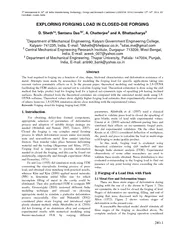PDF-th International & 26th All India Manufacturing Technology, Design and
Author : natalia-silvester | Published Date : 2015-07-23
In this work forging load is evaluated using theoretical estimation using slab method and also through finite element analysis FEM Experimental observations of some
Presentation Embed Code
Download Presentation
Download Presentation The PPT/PDF document "th International & 26th All India Manufa..." is the property of its rightful owner. Permission is granted to download and print the materials on this website for personal, non-commercial use only, and to display it on your personal computer provided you do not modify the materials and that you retain all copyright notices contained in the materials. By downloading content from our website, you accept the terms of this agreement.
th International & 26th All India Manufacturing Technology, Design and: Transcript
Download Rules Of Document
"th International & 26th All India Manufacturing Technology, Design and"The content belongs to its owner. You may download and print it for personal use, without modification, and keep all copyright notices. By downloading, you agree to these terms.
Related Documents














